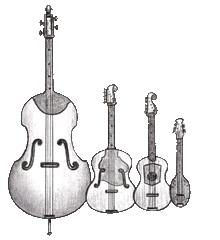 Tamburitza (proper spelling Tamburica, pronounced Tahm-boo-ree-tsa) is the name for the family of stringed instruments native to Croatia. While native to Croatia, the Tamburitza is also the common folk instrument throughout Vojvodina, parts of Serbia, and Bosnia-Herzegovina. Because of its longtime presence and development in Croatia, it is recognized as the national folk instrument of the Croatian people.
Tamburitza (proper spelling Tamburica, pronounced Tahm-boo-ree-tsa) is the name for the family of stringed instruments native to Croatia. While native to Croatia, the Tamburitza is also the common folk instrument throughout Vojvodina, parts of Serbia, and Bosnia-Herzegovina. Because of its longtime presence and development in Croatia, it is recognized as the national folk instrument of the Croatian people.
This fretted, lute like, stringed instrument comes in five basic sizes and shapes.
- The oval shaped ‘Prim’ or ‘Bisernica’ is the smallest of the five and plays the melody and harmony in the highest octaves.
- The tenor guitar shaped ‘Brac’ or ‘Basprim’ is the next largest and plays the melody and harmony in the mid range octaves.
- The Guitar shaped ‘Celo’ is approximately the size of a folk guitar and plays counter melody in the lower octaves, much like a cello in a symphony.
- The ‘Bugarija’ or ‘Kontra’ is similar in size and shape of the celo and plays only chords for counter rythm.
- The double bass shaped ‘Bas’ plays the bass part of the rhythm in the lowest octaves. Like the other instruments in the tamburitza family, the Bas is fretted, has wire strings, and is played with a pick.
The tamburitza originated as a peasant folk instrument, with groups of five or six musicians playing simple folk songs and dances at weddings and other gatherings. Only after the turn of the Twentieth century did large orchestras begin to form and formal compositions were written. It was the evolution of the large orchestra and ‘classical’ compositions that helped the tamburitza gain recognition and appreciation by the international community. Unfortunately, the Tamburitza remains and instrument that is relatively unknown outside of the folk music world.
